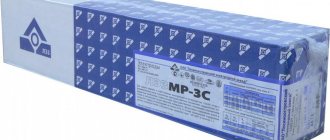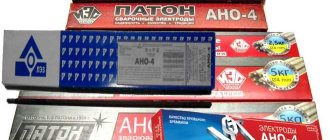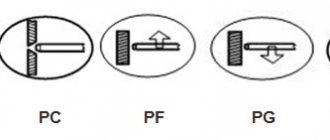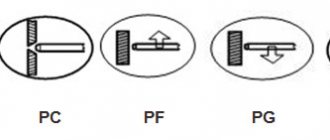- VetConsultPlus
- Cardiological Encyclopedic Dictionary
Electrochemical electrodes
(Greek Elektron - amber + hodos - road, path) - electronic current conductors (metals, graphite) that are in contact with ionic current conductors (electrolytes). For any electrochemical process, an electrochemical cell must have at least two electrochemical electrodes, immersed in the same electrolyte or in different ones, which are in contact with each other. The passage of current through such a system is accompanied by a change in the type of current carrier at the electrode-electrolyte interface. The continuous passage of current through the interphase network is ensured by the electrochemical reaction in it.
Electrochemical electrodes to which positively charged ions (cations) move under the influence of an external current are called a cathode. Cations accept electrons from the cathode and are reduced there. The electrodes to which negatively charged ions (anions) move under the influence of an external current are called anode. Anions donate electrons to the anode and are oxidized there. The course of such electrochemical reactions at the cathode and anode can take place both with and without the participation of the electrochemical electrode material.
Classification
Classification of electrochemical electrodes.
Type 1 - metal or gas, immersed in an electrolyte solution containing ions of the material. Such circulating ions still exist. Eg. on silver E.E. Ag | Ag + a potential reaction occurs: AgDAg + + 1ē. In gas electrochemical electrodes, the role of metal should be played by electrochemical active gases (hydrogen, chlorine, oxygen, etc.), but they are not electronic conductors of current, therefore electrical contact in gas electrochemical electrodes is carried out using inert metals (platinum, gold, palladium), which serve as transmitters of electrons from gas molecules to solution ions and vice versa. For example, chlorine electrode Pt, Cl2 | Cl- is a platinum plate, which is immersed in a solution with Cl - ions and washed by a uniform flow of Cl2 gas with pressure РCl2. Cl2 gas is adsorbed on a platinum plate, then decomposes into Clads atoms, which are already directly involved in the electrochemical reaction: Cl2 2arrow.eps 2Clads 2arrow.eps 2Cl- + 2ē.
Electrodes of the 1st type also include amalgam electrodes, for example, sodium amalgam, in which sodium amalgam plays the role of a metal ingredient. On such an E.E. The potential-viral reaction proceeds as follows: Na + + ē (Hg) 2arrow.eps Na (Hg).
Electrochemical electrodes of the 2nd type are metals coated with a layer of their sparingly soluble salts and immersed in an electrolyte solution containing a common anion from the sparingly soluble salt. This group includes reference electrodes - silver chloride (Ag, AgCl | Cl-), calomel (Hg, Hg2Cl2 | Cl-), mercury sulfate (Hg, HgSO4 | SO42-). Potential-forming reaction, for example. on silver chloride E.E., goes as follows: AgCl + ē 2arrow.eps Ag + Cl-.
Electrochemical electrodes of the 3rd type are metals coated with two layers of two sparingly soluble salts. The first salt is less soluble than the second, and contains a metal cation electrochemical electrode. The second salt is more soluble than the first and retains the same anion as the first. For example, oxalate electrode of the 3rd kind Ag, Ag2C2O4, CaC2O4 | Ca2+.
The potential reaction on such electrochemical electrodes proceeds as follows: Ag2C2O4 + 2ē + Ca 2+ 2arrow.eps 2Ag + CaC2O4. Redox electrochemical electrodes (Redox electrodes) are metals whose material does not participate in the electrochemical reaction, but only acts as a transmitter of electrons from the reduced form to the oxidized one or vice versa. Eg: Fe3 + + 1ē 2arrow.eps Fe2 +. In such a reaction, the redox E.E. carries out electron transfer between these ions.
where aokis., avidn. — activity of the oxidized and reduced forms, respectively; n is the number of electrons that participates in the redox reaction.
Modified electrochemical electrodes, the surface of which is modified using physical or chemical methods in order to impart certain characteristics to it. For example, during physical modification, ion implantation, loosening of the surface or growing monocrystalline structures on it, etc. are carried out. In chemical modification, the surface of the electrode is coated with organic, organometallic or inorganic layers, created on the surface. Composites with electrode materials change the chemical composition of the surface of the device and the like. In particular, by chemical modification of the surface of ion-selective species with the functions of inorganic ions, ion-selective electrodes with the functions of organic ions of medicinal substances were obtained: procaine, lidocaine, sodium diclofenac, etc.
The designs and sizes of electrochemical electrodes are varied. They come in the form of a rod, plate, ball, mesh, etc. The surface of ultramicroelectrodes does not exceed 10-14 m2. EE, which are used in electroanalytical methods of analysis, have a surface of about 10-5 m2; electrodes that are used in the electrochemical synthesis of drugs, for example, calcium gluconate, have a surface area of more than 10-2 m2.
see also Ion selective electrodes.
The Nernst equation for measuring pH can be written as
E = Eu + St (pH t – pHi), (3)
Where
Ei, pHi - nominal values of the coordinates of the isopotential point of the electrode system, consisting of glass (measuring) and auxiliary electrodes, respectively, mV, pH;
pH t - pH value of the buffer solution at temperature t, ºС;
St is the slope of the hydrogen characteristic in mV/pH at temperature t ºС, calculated by the formula
(4)
Where
t—temperature of the analyzed medium, ºС;
n is the charge of the ion.
The slope of the electrode system St depends on temperature; at a temperature of 25ºC and a tenfold change in the activity of the ion being determined, it is equal to 59.16 mV for singly charged ions and 29.56 for doubly charged ions. However, usually the slope of the electrode function is less than the theoretical value, which is due to the presence of interfering impurities or aging of the liquid electrode.
For the convenience of estimating the real steepness of the electrode system St real, as a rule, a dimensionless coefficient K S is used, which takes into account the deviation of the real steepness from the theoretical value;
(5)
Where
St real—real value of the slope of the electrode function, mV/pH;
St is the theoretical value of the electrode function slope, calculated using formula (4), mV/pH.
The coefficient K S, generally equal to 0.8...1.2, allows us to take into account the deviation of the slope of the electrode system St real from the theoretical value.
Good to know ^Top
- Sorbitan ester
- Ecomorph
- Econometrics or econometrics
- Enterprise economy
- Exicosis
- Ethylmorphine hydrochloride (Ethylmorphini hydrochloridum) - formula, properties and application
- Electroplasmolysis
- Ergastic substances
- Echography of dogs and cats
- Erythritol
- Environmental assessment
- Environmental management of pharmaceutical enterprises
- Exclusivity of clinical trial data
- Excretion
- Experiment
- Expert system
- Chemical equivalent
- Environmental monitoring of the enterprise
- Ecology
- Plant ecology
- Ethylenimine
- Ethyl lactate
- Ebullioscopy
- Accounting in a pharmaceutical company
- Ecdysteroids hormones of molting and metamorphosis
- Ecobiotechnology - applied science
- Euphoria
- Etophylline (Etofyllinum)
- Eucalyptus (biology, industrial, medical and medicinal properties)
- Evolution (terminology, theory, process)
- Euthanasia, euthanasia, euthonasia (terminology, problems)
pH electrodes are not sealed design
Production and production of the simplest electrodes of a non-sealed design (Figure 2) only for measuring pH values in a narrow range.
Figure 2. Non-soldered electrode
In laboratory glass electrodes of a non-sealed design , especially with temperature changes in the analyzed environment, the seal may be compromised; the internal buffer solution interacts not only with the glass of the electrode body, but also with other materials that provide sealing (rubber, resin, etc.). As a result of this, the internal solution changes its composition, which leads to a rapid change in the control potential of the electrode and a change in the coordinates of the isopotential point.
We are now producing more sophisticated sealed glass electrodes not only for measuring pH over a wide range from -0.5 to 14 pH, but also for measuring other ions.
pH electrodes of sealed design
Production of electrodes of sealed design.
Figure 3. Electrode of sealed design
Advantages of electrodes of a sealed design (Figure 3). The internal buffer solution filling the electrode body is located in a sealed glass flask; it does not come into contact with any other materials except glass, and therefore retains its composition even with sudden changes in temperature of the analyzed environment, as a result of which the potential of the electrode remains practically unchanged for a long time , which has a positive effect on the performance of the electrodes.
Advantages of glass electrodes
Measuring glass electrodes with internal filling - sealed design, the advantages of electrodes of a sealed design were discussed earlier.
In addition, to eliminate the influence of static electricity on the readings of measuring high-resistance laboratory electrodes: ESL-43-07, ESL-43-07SR,
ESL-63-07, ESL-63-07SR, ESL-45-11, ESL-15-11, ESL-51-07, ESL-51-07SR, ES-10-07, and also ESP-31-06, ES-71-11 we not only use a silent shielded coaxial cable with an insulation resistance of more than 1012 Ohms, but also shield the inside of the electrode with a metal screen, which reduces potential drift.
In the operational documents, we indicate the linear range of the ionic characteristics of the electrodes not only for temperatures of 25 ºС (20 ºС), but also for the maximum temperatures of the analyzed medium (requirement of state standards), which allows the consumer to correctly select the electrode necessary for their conditions, while others Manufacturers standardize the linear range of the ionic characteristic only for a temperature of 25 ºС.
In regulatory and operational documents for measuring electrodes, we indicate the optimal ranges for the temperature of the analyzed medium and measurement limits, which allows the consumer to choose the right electrode to ensure long-term operation of the electrodes without deteriorating their characteristics.
For all glass pH electrodes, the interfering ions are alkali metal ions - mainly sodium ion, so we normalize the upper values of the linear range of the hydrogen characteristic of pH electrodes with the interfering influence of sodium ions equal to 0.1 mol/l (requirement of state standards).
In the absence of interfering ions, most glass pH electrodes have a linear function up to pH = 14.
In addition to measuring electrodes, auxiliary electrodes (comparisons) for both industrial and laboratory conditions.
These are laboratory electrodes EVL-1M3.1, EVL-1M4, industrial electrodes EVP-08, EKhSV-1, electrodes 5M2.840.072 5M2.840.072 for laboratory analyzers AN-7529/60 and AS-7932.
Reference electrode 2nd category ESO-01
The only standard reference electrode of the 2nd category ESO-01 in the post-Soviet space is being produced.
Auxiliary electrodes (comparison): EVL-1M3.1, EVL-1M4, EVP-08,
EKhSV-1, ESO-01, produced by the plant, are saturated silver chloride, therefore the potential of the electrodes is stable, does not depend on changes in the concentration of the internal solution when the temperature changes, the temperature coefficient of the potential of the electrodes does not change its sign depending on the temperature of the solution.
The potential-generating part of laboratory electrodes is located in the upper part of the electrode body and is not immersed in the controlled solution, so the influence of the temperature of the controlled solution is minimal.
Through the electrolytic key of the auxiliary electrode, the auxiliary electrode is connected to the analyzed solution. A diffusion potential arises at the electrolytic switch. The diffusion potential of the auxiliary electrode varies depending on the design of the electrolytic switch and the rate of flow of electrolyte through the electrolytic switch. If the electrolyte flow rate through the switch is low or uneven, the diffusion potential changes, resulting in incorrect measurements. When making accurate measurements, care must be taken to ensure the constancy of diffusion potentials.
Practice states that when using keys with a low flow rate, the diffusion potential is unstable. The instability of the diffusion potential of ceramic keys can also be caused by blockage of the salt bridge pores with dirt, sediment or potassium chloride crystals. The change in diffusion potential on a ceramic key can reach 12 mV.











